|
Converting
a traditional IRA into a Roth IRA can be a wise idea,
depending on your circumstances. It's true that a
conversion will trigger a current federal income tax bill,
which is generally based on the balance of your traditional
IRA reduced by any nondeductible contributions.
However, the following benefits will likely make the
transaction worth it:
|
Begin Planning for a Roth IRA Conversion
Now! |
|

|
|
Income Limits on
Roth IRA Contributions
The
article to the left assumes that you’re ineligible to
make annual Roth IRA contributions because your income
is too high. The ability to make such contributions is
phased out between modified AGI of $95,000 to $110,000
for unmarried taxpayers (between $150,000 to $160,000
for joint filers).
Your
eligibility to make annual Roth contributions is
unaffected by whether you (or your spouse, if married)
participate in an employer-sponsored retirement
plan.
Annual Roth IRA
contributions are limited to the same amounts as
traditional IRAs. Obviously, if you are interested and
eligible to make annual Roth contributions based on your
income, you should do that instead of contributing to a
traditional IRA and converting.
|
- Future
income and gains earned in the Roth account are allowed to
accumulate federal-income-tax-free.
- Money
in your Roth IRA can then be withdrawn
federal-income-tax-free after the account is at least five
years old and you’ve reached age 59 1/2.
- In
addition, your Roth IRA is exempt from the required minimum
distribution rules which force you to begin taking annual
withdrawals after age 70 1/2. In contrast, other
tax-advantaged retirement accounts, including traditional
IRAs, are subject to the mandatory distribution rules.
For these
reasons, a Roth conversion can be a very attractive tax
strategy.
Conversions are Currently Limited,
But Stay
Tuned
There’s one big current problem with the Roth conversion
idea for taxpayers with high incomes: You’re not eligible for
the conversion privilege in any year that your modified
adjusted gross income (MAGI) exceeds $100,000.
However, the new Tax Increase Prevention and
Reconciliation Act, enacted in May, eliminates the
unfavorable MAGI restriction. Unfortunately, this
taxpayer-friendly change doesn’t kick in until 2010. So until
then, the current $100,000 MAGI rule will continue to prevent
higher-income folks from taking advantage of the Roth
conversation strategy.
Is There Anything You Can Do
Now?
If you want to plan ahead for the upcoming unlimited
Roth conversion bonanza, you can do so by loading up your
traditional IRA with as much money as possible between now and
then. That way, you will have a substantial balance that can
be converted to Roth status in 2010.
If you are in the
high-income category, you probably can’t make any deductible
traditional IRA contributions (see bottom right-hand box for
the rules). But you can always make nondeductible
traditional IRA contributions if you have earned income for
the year and have not reached age 70 1/2. You can receive
earned income from salary as an employee, from self-employment
activities, or even from alimony payments made to you by your
ex-spouse.
How much can you contribute to a nondeductible traditional
IRA? For the 2006 and 2007 tax years, you can put in the
lesser of:
1. $4,000 ($5,000 if you’ll be
age 50 or older as of the end of the year) or
2. Earned income.
For 2008 through 2010, the amounts increase. You can
contribute the lesser of: $5,000 ($6,000 for those age 50 or
older as of year-end) or earned income. If you’re married, the
same contribution limits apply to your spouse so he or she can
fund a separate nondeductible IRA.
Therefore, if you are under age 50, you can contribute up
to $23,000 for the 2006 through 2010 tax years ($4,000 each
for 2006 and 2007 equals $8,000 plus $15,000 for the $5,000
contributions for 2008, 2009 and 2010). If you will be 50 or
older at the end of all those years, you can contribute up to
$28,000. The same goes for your spouse. Then in 2010, you can
convert your nondeductible traditional IRA into a tax-free
Roth account.
Assuming you have no other traditional
IRAs (including SEP accounts and SIMPLE-IRAS), you would only
be taxed on the earnings that have accumulated in your
nondeductible IRA.
The deadline for making a nondeductible traditional IRA
contribution for each tax year is April 15 of the following
year (the date is extended until the next business day if it
falls on a Saturday or Sunday). But you can also make your
contribution for each year as early as January 1 of that year.
Once you turn 70 1/2, you can no longer contribute to a
traditional IRA.
But Will the Roth Conversion Rules
Really Change in 2010?
Skeptics
have noted that Congress could decide to change its mind in
the future and eliminate this favorable provision before it
ever becomes effective. They argue that if there is a change
of political power in Washington, it will not survive.
Even if you’re not convinced that the new Roth
conversion rules will actually go into effect in 2010,
following this strategy of putting the maximum in
nondeductible traditional IRA contributions between now and
then doesn’t have much downside. Why? Because you will at
least get the advantage of tax-deferred earnings with a
nondeductible traditional IRA. The chance to possibly convert
the traditional account into a tax-free Roth IRA down the road
is just icing on the cake. So if you want to plan ahead, there
is no big reason not to do so, as long as you realize the
possibility of political change.

|












